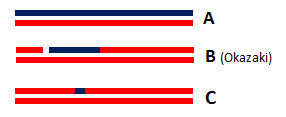Sandbox Reserved 967
From Proteopedia
(Difference between revisions)
| Line 22: | Line 22: | ||
===A heteromeric complex=== | ===A heteromeric complex=== | ||
| - | |||
It has been shown that the Mammalian RNase complex is a heteromeric complex formed by 3 distinct proteins: <scene name='60/604486/H2a/1'>H2A</scene>,<scene name='60/604486/H2b/1'>H2B</scene> and <scene name='60/604486/H2c/1'>H2C</scene>. H2A protein is the catalytic subunit and H2B/H2C proteins are auxiliary subunits: they are structural domains that facilitate cohesion of the complex<ref name="ref5"> Shaban, Nadine M., Scott Harvey, Fred W. Perrino, and Thomas Hollis. “The Structure of the Mammalian RNase H2 Complex Provides Insight into RNA•DNA Hybrid Processing to Prevent Immune Dysfunction.” Journal of Biological Chemistry 285, no. 6 (February 5, 2010): 3617–24. [http://dx.doi.org/10.1074/jbc.M109.059048 doi:10.1074/jbc.M109.059048.]</ref>. | It has been shown that the Mammalian RNase complex is a heteromeric complex formed by 3 distinct proteins: <scene name='60/604486/H2a/1'>H2A</scene>,<scene name='60/604486/H2b/1'>H2B</scene> and <scene name='60/604486/H2c/1'>H2C</scene>. H2A protein is the catalytic subunit and H2B/H2C proteins are auxiliary subunits: they are structural domains that facilitate cohesion of the complex<ref name="ref5"> Shaban, Nadine M., Scott Harvey, Fred W. Perrino, and Thomas Hollis. “The Structure of the Mammalian RNase H2 Complex Provides Insight into RNA•DNA Hybrid Processing to Prevent Immune Dysfunction.” Journal of Biological Chemistry 285, no. 6 (February 5, 2010): 3617–24. [http://dx.doi.org/10.1074/jbc.M109.059048 doi:10.1074/jbc.M109.059048.]</ref>. | ||
The first domain structure of the complex, H2A, contains 301 amino acids, almost as H2B protein which computes 308 amino acids. H2C protein is the smallest subunit: it only has 166 amino acids. | The first domain structure of the complex, H2A, contains 301 amino acids, almost as H2B protein which computes 308 amino acids. H2C protein is the smallest subunit: it only has 166 amino acids. | ||
Each of these proteins adopts various secondary structures with β-strands and α-helices: | Each of these proteins adopts various secondary structures with β-strands and α-helices: | ||
| - | + | H2A protein has 12 α-helices, 11 β-strands and 3 turns<ref> http://www.uniprot.org/uniprot/Q9CWY8</ref>, | |
| - | + | H2B molecule computes 8 α-helices, 7 β-strands and 3 turns<ref> http://www.uniprot.org/uniprot/Q80ZV0</ref>, | |
| - | + | H2C subunit consists of 5 α-helices, 8 β-strands and 2 turns<ref> http://www.uniprot.org/uniprot/Q9CQ18</ref>. | |
=== Several interactions between the subunits === | === Several interactions between the subunits === | ||
| - | |||
H2C protein is found in the middle of the elongated complex structure, flanked by H2A and H2B proteins on the ends. | H2C protein is found in the middle of the elongated complex structure, flanked by H2A and H2B proteins on the ends. | ||
The complex is stabilized by the intimately interwoven architecture of H2B and H2C: The N-terminal region of H2B protein (amino acids 1-92) weaves together with H2C domain to form 3 β-barrels, called <scene name='60/604486/Triple_barrel/2'>“triple barrel”</scene><ref name ="ref9"> Nicholson, Allen W. Ribonucleases. Springer Science & Business Media, 2011.</ref>. This triple barrel is formed from a total of <scene name='60/604486/Triple_barrel/1'>18 β-sheets</scene> and produces a pseudo-2-fold axis of symmetry along the central barrel. Also, it permits to leave the mostly α-helical C-terminal region of H2B available for potential interactions with other protein (for example the PCNA protein). Finally, it has been found that the motif provides a platform for securely binding the H2A protein: the side and end of the first barrel in the subcomplex H2B/H2C form a <scene name='60/604486/Tight_interface_h2ah2c/2'>tight interface</scene> with amino acids 197-258 in the C-terminal region of H2A protein. This interface is mainly composed of hydrophobic residues <ref name="ref5">. | The complex is stabilized by the intimately interwoven architecture of H2B and H2C: The N-terminal region of H2B protein (amino acids 1-92) weaves together with H2C domain to form 3 β-barrels, called <scene name='60/604486/Triple_barrel/2'>“triple barrel”</scene><ref name ="ref9"> Nicholson, Allen W. Ribonucleases. Springer Science & Business Media, 2011.</ref>. This triple barrel is formed from a total of <scene name='60/604486/Triple_barrel/1'>18 β-sheets</scene> and produces a pseudo-2-fold axis of symmetry along the central barrel. Also, it permits to leave the mostly α-helical C-terminal region of H2B available for potential interactions with other protein (for example the PCNA protein). Finally, it has been found that the motif provides a platform for securely binding the H2A protein: the side and end of the first barrel in the subcomplex H2B/H2C form a <scene name='60/604486/Tight_interface_h2ah2c/2'>tight interface</scene> with amino acids 197-258 in the C-terminal region of H2A protein. This interface is mainly composed of hydrophobic residues <ref name="ref5">. | ||
| Line 43: | Line 41: | ||
== Activity == | == Activity == | ||
| - | |||
The RNase H2 recognize 2’OH group of ribonucleotides in RNA at RNA/DNA junction and cannot cleave unhybridized RNA. The phosphodiester hydrolysis catalysed by the RNase H2 is likely following a two-metal ion-dependent mechanism quite common for phosphoryl hydrolases like RNase H enzymes. | The RNase H2 recognize 2’OH group of ribonucleotides in RNA at RNA/DNA junction and cannot cleave unhybridized RNA. The phosphodiester hydrolysis catalysed by the RNase H2 is likely following a two-metal ion-dependent mechanism quite common for phosphoryl hydrolases like RNase H enzymes. | ||
| Line 57: | Line 54: | ||
</StructureSection> | </StructureSection> | ||
| + | |||
| + | == References == | ||
| + | </references> | ||
== Proteopedia page contributors and editors == | == Proteopedia page contributors and editors == | ||
Anaïs Bourbigot & Valériane Keïta | Anaïs Bourbigot & Valériane Keïta | ||
Revision as of 19:57, 9 January 2015
| This Sandbox is Reserved from 15/11/2014, through 15/05/2015 for use in the course "Biomolecule" taught by Bruno Kieffer at the Strasbourg University. This reservation includes Sandbox Reserved 951 through Sandbox Reserved 975. |
To get started:
More help: Help:Editing |
Structure of the Mouse RNase H2 Complex
| |||||||||||
References
</references>
Proteopedia page contributors and editors
Anaïs Bourbigot & Valériane Keïta

